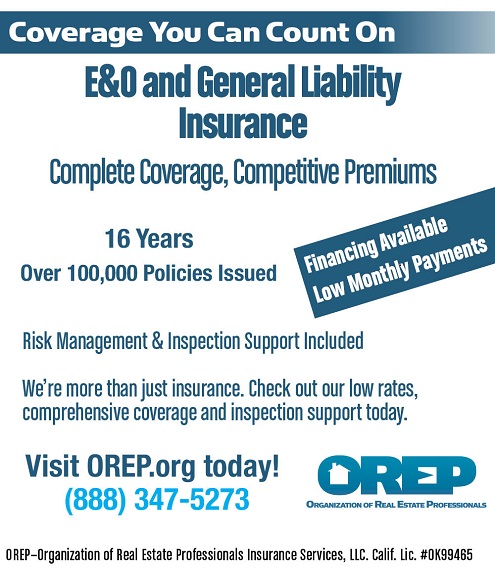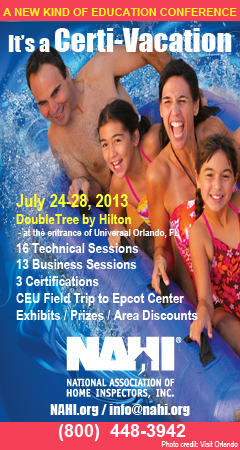
|
Home Inspectors Edition | Circulation 20,000 | Advertise | Subscribe | |
Published by OREP, E&O Insurance Experts | May 2013 |
 Click to Read Current Issue |
>
Click to Print
|
Pullig's research
demonstrates that in these still-dodgy times for the real estate industry,
it's vitally important to be proactive in your quest for customers.
Editor's Note: While written for real estate sales professionals, the following story shows all businesspersons how understanding your own style can make "selling" a little easier.
The Relationship Business - Part 1
By Melissa Dittmann Tracey
Every day holds new possibilities for creating connections. When you find
people with whom you have something in common, relationships are likely to
sprout. They can occur over shared interests—butterfly gardens, Bundt cake
recipes, bike riding—or shared friends. “If you and I have someone in common
or a common interest, that makes me like you a little more and want to chat
more,” says Michelle Tillis Lederman, author of
The 11 Laws of Likability
(AMACOM, 2012). “When we discover similarities, we form deeper and more
lasting connections.”
(story continues below)
(story continues)
Allen “Al” Rusca, ABR, e-PRO, wears his “Diane Turton, REALTORS®” name badge
around town. “That badge opens many doors for me when the inevitable
question arises: ‘How’s the real estate market these days?’ ” says Rusca, a
salesperson based in Ocean Grove, N.J. “I’ve gotten business from the local
coffee shop, the barber shop, the dry cleaners, the grocery store, the gas
station, the doctor’s office, the bank, my church, the local senior center,
and more. Being visible and active in the community is the best way to find
new business.”
If
you’re going to spend time on online social networks, do it with a keen
understanding of what each network delivers. Pinterest, for example, has
been called a “woman’s social network.” The site—which enables you to pin
Web content you like to your personal or business page and share it with
your Pinterest followers—has an audience that’s more than 82 percent female.
Because women are big influencers in home purchase decisions—and “home” is
the No. 1 category of “pins” on Pinterest, according to a study by R.J.
Metrics—it may be a good play for making meaningful connections with female
buyers. (Pinterest recently added the ability to create business pages and
created separate terms of service for businesses.)
One enthusiast is Sue Eller, a sales associate with Dilbeck Real Estate Real
Living in La Canada, Calif., who has pinned hundreds of photos of local
architectural gems, parks, and more. “Pinterest is a good way to build
affinity marketing by connecting over not just real estate but also hobbies
and interests,” Eller says. Eller posts architectural photos she loves on
her Web site and uses Pinterest to drive traffic there.
Her Pinterest page
also includes categories such as “How to Make Your Home Sellable,” “Favorite
Homes I Have Sold,” and “Gardening and Gardens.”
Bryce Fuller, a broker with Coldwell Banker in Northbrook, Ill., hosts a
neighborhood open house each year. It’s a way to meet the neighbors and
establish himself as the local expert with a vested interest in home values.
Fuller provides each family that attends with a neighborhood market
analysis. “The BBQ allows people to approach me, get to know me, and ask
questions,” he says. “As they spend more time around me, their comfort level
increases. That comfort level and trust coupled with my listing signs and
activity in the subdivision is a one-two punch that can’t be beat.”
Tip:
Have a “wingman” sing your praises.
Boasting about your own sales record and accomplishments can come across as
arrogant, says Kurt W. Mortensen, author of
The Laws of Charisma
(AMACOM, 2010). But if you can get others to say it for you, it’s powerful.
Getting friends to introduce you to their peers, for example, gives you
built-in credibility, Mortensen says. Testimonials on your Web site or
LinkedIn account can be just as powerful. “Written reviews from satisfied
customers enable trust to be formed more quickly,” says Michael Davenport, a
broker-associate with King Realty Associates LLC in Sarasota, Fla.
*Reprinted from the January/February 2013 issue of REALTOR Magazine
by permission of the NATIONAL ASSOCIATION OF REALTORS. Copyright 2013. All
rights reserved.
ATTENTION: You are receiving WRE Online News because you opted in at WorkingRE.com or purchased E&O insurance from OREP. WRE Online News Edition provides news-oriented content twice a month. The content for WRE Special Offer Editions is provided by paid sponsors. If you no longer wish to receive these emails from Working RE, please use the link found at the bottom of this newsletter to be removed from our mailing list.





